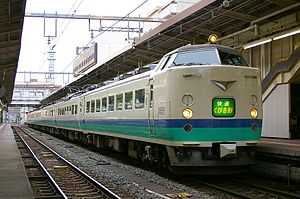Kubikino
| Kubikino | |
|---|---|
 485 series EMU on a Kubikino rapid service, March 2007 | |
| Overview | |
| Service type | Rapid |
| Locale | Shinetsu Main Line |
| Predecessor | Minori |
| First service | 1 December 2002 |
| Current operator(s) | JR East |
| Route | |
| Start | Niigata |
| End | Arai |
| Service frequency | 3 return services daily |
| On-board services | |
| Class(es) | Green + Standard |
| Technical | |
| Rolling stock | 485 series EMUs |
| Track gauge | 1,067 mm (3 ft 6 in) |
| Electrification | 1,500 V DC overhead |
| Operating speed | 120 km/h (75 mph) |
The Kubikino (くびき野) is a "Rapid" limited-stop train service in Japan operated by the East Japan Railway Company (JR East) between Niigata and Arai on the Shinetsu Main Line in Niigata Prefecture since 2002.[1]
Service pattern
Services consist of three trains in each direction daily.[1][2]
Rolling stock
Services are formed of 6-car 485 series EMUs, which include Green car (first class) accommodation. Niigata-based sets T16 and T17 are normally allocated to Kubikino duties, as these two sets did not receive the Green car seat refurbishment applied to other 485 sets used on Inaho limited express services in 2007.[1][3]
-

Niigata-based set T-16 on a Kubikino service, May 2012
-

Niigata-based JNR-liveried set K-2 on a Kubikino service, May 2012
Formation
Trains are formed as shown below, with car 1 at the Arai end.[1][4]
| Car No. | 1 | 2 | 3 | 4 | 5 | 6 | |
|---|---|---|---|---|---|---|---|
| Numbering | KuRoHa 481 | MoHa 484 | MoHa 485 | MoHa 484 | MoHa 485 | KuHa 481 | |
| Accommodation | Green | Reserved | Non-reserved | Non-reserved | Non-reserved | Non-reserved | Non-reserved |
History
The Kubikino services commenced from the start of the revised timetable on 1 December 2002, replacing the previous Minori limited express services.[1] 4-car 485 series were initially used on these services, but 6-car Inaho 485 series sets were used from 20 May 2006 to relieve overcrowding.[1]
A predecessor to the Kubikino rapid service, the Kubiki (くびき), operated as a semi-express between Niigata and Arai from 1 October 1963, and as an express service from 5 March 1966, before being absorbed into Yoneyama (よねやま) semi-express services operating between Nagano and Niigata from 30 September 1968.[5][6]
References
| Wikimedia Commons has media related to Kubikino. |
- ↑ 1.0 1.1 1.2 1.3 1.4 1.5 JR新幹線&特急列車ファイル [JR Shinkansen & Limited Express Train File]. Japan: Kōtsū Shimbun. 2008. p. 140. ISBN 978-4-330-00608-6.
- ↑ JR Timetable, August 2011 issue, p.570-579
- ↑ "越後路をめぐる国鉄型車両の現況" [The Current State of JNR Rolling Stock on Echigo Routes]. Tetsudō Daiya Jōhō Magazine (Japan: Kōtsū Shimbun) 40 (330): p.12–23. October 2011.
- ↑ JR電車編成表 2012冬 [JR EMU Formations - Winter 2012]. Japan: JRR. October 2011. p. 35. ISBN 978-4-330-25611-5.
- ↑ 列車名鑑1995 [Train Name Directory 1995]. Japan: Railway Journal. August 1995. p. 125.
- ↑ Teramoto, Mitsuteru (July 2001). 国鉄・JR列車名大辞典 [JNR & JR Train Name Encyclopedia]. Tokyo, Japan: Chuoshoin Publishing Co., Ltd. pp. 215–216. ISBN 4-88732-093-0.
| ||||||||||||||||||||||
.svg.png)